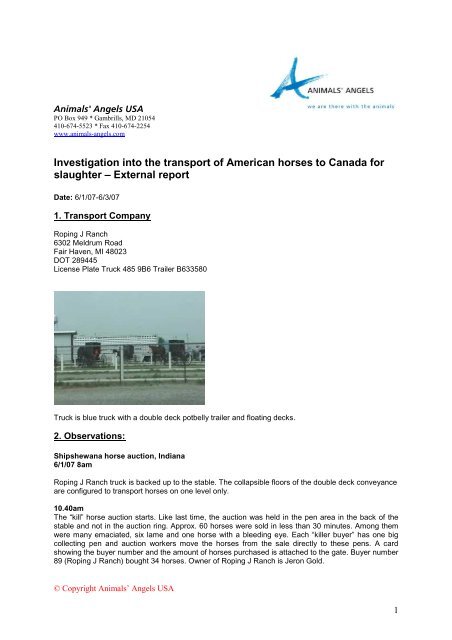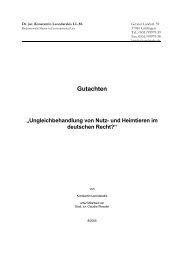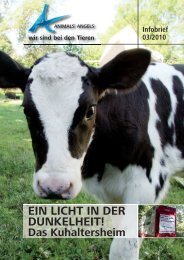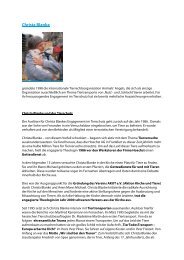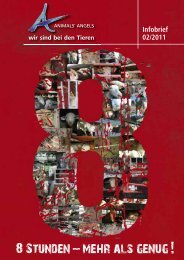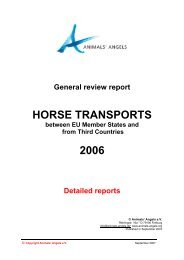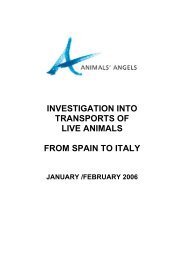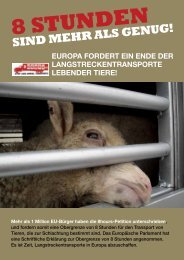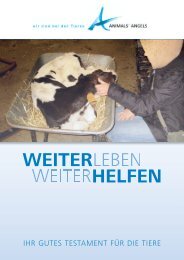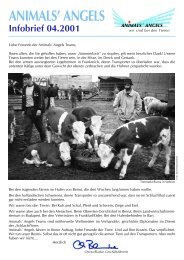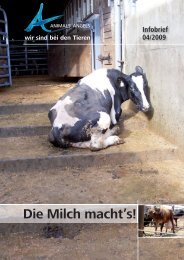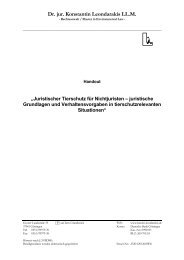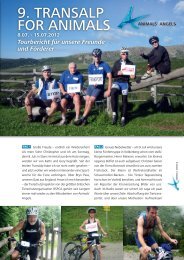You also want an ePaper? Increase the reach of your titles
YUMPU automatically turns print PDFs into web optimized ePapers that Google loves.
<strong>Animals'</strong> <strong>Angels</strong> USA<br />
PO Box 949 * Gambrills, MD 21054<br />
410-674-5523 * Fax 410-674-2254<br />
www.animals-angels.com<br />
Investigation into the transport of American horses to Canada for<br />
slaughter – <strong>External</strong> <strong>report</strong><br />
Date: 6/1/07-6/3/07<br />
1. Transport Company<br />
Roping J Ranch<br />
6302 Meldrum Road<br />
Fair Haven, MI 48023<br />
DOT 289445<br />
License Plate Truck 485 9B6 Trailer B633580<br />
Truck is blue truck with a double deck potbelly trailer and floating decks.<br />
2. Observations:<br />
Shipshewana horse auction, Indiana<br />
6/1/07 8am<br />
Roping J Ranch truck is backed up to the stable. The collapsible floors of the double deck conveyance<br />
are configured to transport horses on one level only.<br />
10.40am<br />
The “kill” horse auction starts. Like last time, the auction was held in the pen area in the back of the<br />
stable and not in the auction ring. Approx. 60 horses were sold in less than 30 minutes. Among them<br />
were many emaciated, six lame and one horse with a bleeding eye. Each “killer buyer” has one big<br />
collecting pen and auction workers move the horses from the sale directly to these pens. A card<br />
showing the buyer number and the amount of horses purchased is attached to the gate. Buyer number<br />
89 (Roping J Ranch) bought 34 horses. Owner of Roping J Ranch is Jeron Gold.<br />
© Copyright Animals’ <strong>Angels</strong> USA<br />
1
- <strong>External</strong> <strong>report</strong> -<br />
None of the pens have any water or food for the animals. The six limping horses and the one with<br />
the bleeding eye injury were sold to Roping J Ranch as well.<br />
Eye Injury<br />
12.30pm<br />
Roping J Ranch and two unknown guys start to put green USDA slaughter tags on each horse.<br />
Green Slaughter Tags<br />
1.05 pm<br />
Roping J Ranch loads the first 16 horses on the double deck truck. They are moved with wooden<br />
sticks. The floating deck is adjusted and the horses are only loaded on one level. However, with 16<br />
horses being loaded into the first compartment, loading density in this compartment is very high.<br />
1.50 pm<br />
The second pen with at least 12 horses is loaded onto the truck. The animals struggle as they are<br />
forced into the second compartment. Standing next to the trailer, you can hear the animals kicking<br />
inside.<br />
Two pick-up trucks with single trailers back up to the loading ramps. The two guys who helped Roping<br />
J with his horses start loading horses on their trucks as well. All these horses also have the green<br />
slaughter tag attached.<br />
© Copyright Animals’ <strong>Angels</strong> USA<br />
2
- <strong>External</strong> <strong>report</strong> -<br />
2.50pm<br />
The truck leaves the loading dock and parks outside of the stable.<br />
3.00pm<br />
The truck leaves the premises. The two pick up trucks with the single trailers follow. There is one<br />
driver in the Roping J Ranch truck.<br />
Possible Violations of the Commercial Transportation of Equines for Slaughter Regulations 9<br />
CFR Sec. 88.4:<br />
(a)<br />
Prior to the commercial transportation of equines to a slaughtering facility, the owner/shipper must:<br />
(1)<br />
For a period of not less than 6 consecutive hours immediately prior to the equines being loaded on the<br />
conveyance, provide each equine appropriate food, potable water and the opportunity to rest.<br />
(4)<br />
Load the equines on the conveyance so that each equine has enough floor space to ensure that no<br />
equine is crowded in a way likely to cause injury or discomfort.<br />
Animals’ <strong>Angels</strong> investigation on March 9, 2007 revealed a similar violation: Roping J Ranch started<br />
loading 2 hours after the auction was over and left the auction 4pm. None of the horses received any<br />
water or food prior to transport.<br />
For more details please request <strong>report</strong>.<br />
They all crossed into Michigan on Road IN 9 N. They continued to drive on MI 66 north to MI 60 E.<br />
4.30 pm<br />
The Roping J truck stops at a CITGO gas station. While filling up the truck, the driver cleans the trailer<br />
with a sponge. He does not check on the animals. The two pick-up trucks did not stop but continued<br />
driving on 60 E.<br />
© Copyright Animals’ <strong>Angels</strong> USA<br />
3
- <strong>External</strong> <strong>report</strong> -<br />
4.45pm<br />
The truck continues driving and takes I- 69 N.<br />
5.30pm<br />
Truck pulls into a truck parking close to exit 32 on I-69 N.<br />
5.42pm<br />
Truck leaves the truck parking and continues driving.<br />
8.00pm<br />
Truck pulls into a MARATHON gas station in Memphis. Again, the driver does not check on the<br />
animals<br />
8.38pm<br />
The truck enters the border crossing to Canada. He parks on the right side of the road and walks into<br />
the USDA office on the left. After 5 minutes, he returns and crosses the US border. Nobody checks on<br />
the animals.<br />
Possible Violations of the Commercial Transportation of Equines for Slaughter Regulations 9<br />
CFR Sec. 88.4:<br />
(b) During transit to the slaughtering facility, the owner/shipper must:<br />
(2) Observe the equines as frequently as circumstances allow, but not less than once every six<br />
hours, to check the physical condition of the equines…<br />
In addition:<br />
Since USDA at the border had to stamp the owner/shipper certificate (Sec. 88.5 c), it is possible that<br />
the form was filled out incorrect. Section 88.4 (3)(x) requires<br />
A statement that the equine was provided access to food, water and rest prior to transport…<br />
Falsification of form 10-13 or knowingly using a falsified form is a criminal offence. (18 U.S.C. Section<br />
1001)<br />
© Copyright Animals’ <strong>Angels</strong> USA<br />
4
- <strong>External</strong> <strong>report</strong> -<br />
Statement of USDA border representative, Blue Ridge Bridge Plaza, Port Huron:<br />
- They are not checking on animals leaving the country, all they do is check the owner/shipper<br />
certificate and the Coggins test.<br />
- They do check animals coming in.<br />
- Their border Veterinarian is only available certain hours. His name is Dr. Brown.<br />
- The Canadian border (CFIA) has to inspect the animals.<br />
8.50pm<br />
The truck enters Canada. Nobody checks on the animals on the Canadian side either.<br />
The truck stops briefly at the border station to attach the seal on the truck.<br />
The U.S. has a Letter of Intent with Canada regarding horses originated in the U.S. destined for<br />
slaughter plants in Canada. It states that,<br />
CFIA at the border will provide veterinary inspection of the horses to verify that the horses are<br />
transported humanely,<br />
© Copyright Animals’ <strong>Angels</strong> USA<br />
5
- <strong>External</strong> <strong>report</strong> -<br />
6/3/07 Roping J Ranch Feedlot, Fairhaven, Michigan<br />
8.10 am<br />
We arrive at Roping Js Feedlot in Fairhaven. It is a large property: Behind the farm house are several<br />
barns and large pastures. Several straight trailers (the same ones we saw at the Shipshewana auction<br />
on Friday) are parked in front of the barn. The outside pen area on the left seems to be for the<br />
“slaughter” horses. There is a loading ramp and Roping Js large truck is backed up to the pen area.<br />
The horses we observed being loaded on the two pick-up trucks at the Shipshewana auction were<br />
evidently hauled to this collecting station Friday afternoon. There are approximately 30 horses in the<br />
outside pens. They still have the green USDA slaughter tags attached to their hips. They have access<br />
to hay and water. Many of them look very emaciated, their heads are hanging down. We observe two<br />
horses severely limping.<br />
8.30 am<br />
The same driver from Friday and a second person start moving the horses. They are loading all of<br />
them into the truck, using just one level of the double deck trailer. The driver uses a long, wooden stick<br />
to move them around. One horse is down and it takes several attempts to make it rise.<br />
9.00 am<br />
The truck leaves the premises and starts driving towards Port Huron on I-94 East. There is only one<br />
driver.<br />
© Copyright Animals’ <strong>Angels</strong> USA<br />
6
- <strong>External</strong> <strong>report</strong> -<br />
9.55 am<br />
The truck arrives at the border. To our surprise, the truck does not stop at the USDA office this time,<br />
but continues driving straight to the toll booth.<br />
Possible Violations of the Commercial Transportation of Equines for Slaughter Regulations 9<br />
CFR Sec. 88.5c:<br />
Any owner/shipper transporting equines to slaughtering facilities outside the United States<br />
must present the owner-shipper certificates to USDA representatives at the border.<br />
10.04 am<br />
He stops at the Canadian customs and walks into the office. Then the trailer door is sealed. Nobody<br />
checks on the animals.<br />
10.20 am<br />
The truck leaves the border and starts driving on I-402 East towards London. He then takes I-401 at<br />
12.40 pm. He continues on I-401 East all the way to Quebec.<br />
8.18 pm<br />
The truck arrives at Richelieu Meat, Inc. in Massueville, Quebec. He pulls in and waits outside the<br />
gate. A few minutes later a slaughterhouse employee on a bicycle arrives and opens the gate for him.<br />
© Copyright Animals’ <strong>Angels</strong> USA<br />
7
- <strong>External</strong> <strong>report</strong> -<br />
He unloads directly into the back holding pen of the slaughter plant. At one point the driver and the<br />
employee check on something inside the truck. The driver then makes a gesture signalizing “It is<br />
sleeping” and they both start laughing.<br />
The horses unloaded are in appalling condition: Many of them are limping (more than the two we<br />
observed limping at the feedlot that morning) and one horse is dead. All of them are very nervous<br />
and once unloaded into the holding pen, several start biting and kicking each other.<br />
After the unloading the driver cleaned out the dirty straw from the trailer. At 9.10 pm he leaves the<br />
premises and starts heading back direction Ontario. The dead horse from his truck remains in the<br />
parking lot.<br />
Violation of the Federal Motor Carrier Safety Regulations 49 CFR, Part 395 (Hours of Service):<br />
Property carrying CMV drivers may drive a maximum of 11 hours after 10 consecutive hours off<br />
duty.<br />
© Copyright Animals’ <strong>Angels</strong> USA<br />
8
- <strong>External</strong> <strong>report</strong> -<br />
3. Conclusions:<br />
- The investigation revealed that the Commercial transport of equines to slaughter regulations<br />
are frequently violated and not enforced.<br />
- Livestock trucks are crossing the borders without proper inspection or papers. This is not<br />
only a severe animal welfare concern but also a Homeland Security and a public health<br />
issue.<br />
- Representatives of USDA and CFIA both appear to not know or not to care what the<br />
regulations are and what they are supposed to do.<br />
Horses are transported without food, water or a chance to rest prior to loading. There is no<br />
inspection of the condition of the horses at the border.<br />
As a result, horses arrive lame or even dead at the slaughter plant.<br />
Animals’ <strong>Angels</strong> asks the authorities in charge to respond to these severe animal welfare<br />
concerns. We recommend that:<br />
- The Secretary assesses civil penalties against Roping J Ranch for the violations of the<br />
regulations listed in this <strong>report</strong>. ($88.6)<br />
Evidence: Animals’ <strong>Angels</strong> video documentation, eye witness testimony.<br />
Roping J Ranch delivers approx. 60 horses to Canada each week and every time Animals’<br />
<strong>Angels</strong> observed him he was violating the regulations and causing unnecessary suffering.<br />
- USDA advises their representatives at the border to enforce the regulations. They have to<br />
make sure that each owner/shipper has filled out the owner/shipper certificate correctly and<br />
presents it to the officer on duty.<br />
- USDA starts to monitor the large auctions selling horses for slaughter. There are only very few<br />
of these auctions in the nation and it would be easy to inspect them at least every few months.<br />
Animals’ <strong>Angels</strong> has been monitoring them on a regular basis and is highly concerned about<br />
the constant violations of federal laws occurring every week. We have never encountered any<br />
USDA representative at one of these auctions.<br />
- USDA reminds CFIA about importance of a veterinary inspection at the port of entry and the<br />
existing letter of intent. It is their duty to verify that horses are being transported humanely and<br />
they have the power to take further enforcement action in case they are not. CFIA should<br />
advise their border representatives.<br />
9


